Dark Energy Is it Q or Lambda
Dark Energy Density in Brane World

Λ (Λ < 0) and M are respectively the bulk cosmological constant and funM3 damental energy scale of five-dimensional gravity. According to the assumption, the metric on the brane world can be written as follows (here five-dimensional suffices are denoted by capital Latin and the four-dimensional suffices by the Greek ones), ds2 = e2A(y) gµν dxµ dxν − dy 2 , where gµν is the metric on the brane and gµν = diag 1, − e2 Here √
2
energy density times the radius of the extra dimension. In supersymmetric grand unified theories (GUT), for instance, in supersymmetric SO(10) model, all of the gauge field coupling constants can be unified. To realize the unification of gravitation with other gauge fields, the fundamental energy scale of five-dimensional gravity should be the same as the supersymmetric GUT energy scale. When we select the supersymmetric GUT energy scale MG as the fundamental energy scale of five-dimensional gravity, simultaneously the radius of the AdS5 space-time is admitted by the astronomical observations, the tiny but nonzero four-dimensional cosmological constant can be acquired, which is slightly smaller than the value given by modern astronomical observations.[3, 4] The possible reasons leading to this smallness are also discussed at the end of this paper.
The physics of dark energy and its applications
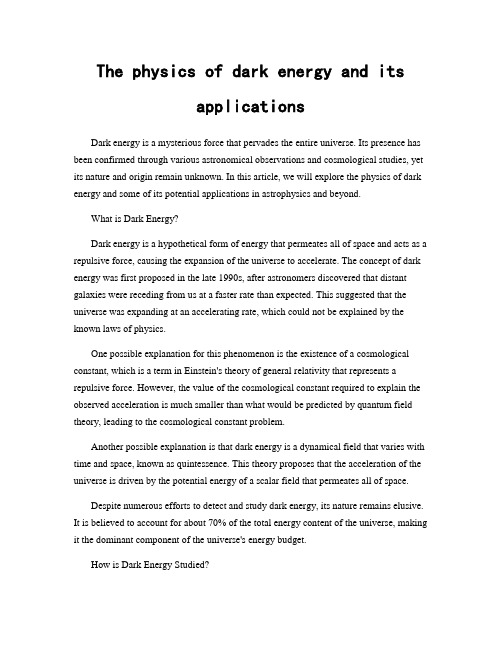
The physics of dark energy and itsapplicationsDark energy is a mysterious force that pervades the entire universe. Its presence has been confirmed through various astronomical observations and cosmological studies, yet its nature and origin remain unknown. In this article, we will explore the physics of dark energy and some of its potential applications in astrophysics and beyond.What is Dark Energy?Dark energy is a hypothetical form of energy that permeates all of space and acts as a repulsive force, causing the expansion of the universe to accelerate. The concept of dark energy was first proposed in the late 1990s, after astronomers discovered that distant galaxies were receding from us at a faster rate than expected. This suggested that the universe was expanding at an accelerating rate, which could not be explained by the known laws of physics.One possible explanation for this phenomenon is the existence of a cosmological constant, which is a term in Einstein's theory of general relativity that represents a repulsive force. However, the value of the cosmological constant required to explain the observed acceleration is much smaller than what would be predicted by quantum field theory, leading to the cosmological constant problem.Another possible explanation is that dark energy is a dynamical field that varies with time and space, known as quintessence. This theory proposes that the acceleration of the universe is driven by the potential energy of a scalar field that permeates all of space.Despite numerous efforts to detect and study dark energy, its nature remains elusive. It is believed to account for about 70% of the total energy content of the universe, making it the dominant component of the universe's energy budget.How is Dark Energy Studied?Dark energy cannot be directly observed or measured in a laboratory, as it interacts very weakly with matter and radiation. Instead, scientists rely on its effects on the expansion of the universe and the large-scale structure of galaxies and galaxy clusters.One of the most important observational probes of dark energy is the cosmic microwave background (CMB) radiation, which is the residual heat left over from the Big Bang. Variations in the CMB provide clues about the geometry and evolution of the universe, as well as the distribution of matter and dark energy.Another powerful tool for studying dark energy is the observation of Type Ia supernovae, which are exploding stars that have a known brightness and can be used as standard candles to measure distances in the universe. By observing how the brightness of these supernovae changes over time, astronomers can infer the expansion rate of the universe and the presence of dark energy.Other methods for studying dark energy include weak gravitational lensing, which measures the distortion of light from distant galaxies as it passes through the intervening matter, and baryon acoustic oscillations, which are periodic ripples in the density of matter that provide a standard ruler for cosmological distances.Applications of Dark EnergyAlthough the nature of dark energy remains enigmatic, its potential applications in astrophysics and beyond have been explored by scientists and engineers.One of the most promising applications of dark energy is in the design of advanced propulsion systems for space exploration. Because dark energy is a repulsive force that acts over long distances, it could be harnessed to propel spacecraft to velocities approaching the speed of light. However, this requires understanding the nature of dark energy more deeply and developing technology that can manipulate it.Another possible application of dark energy is in the development of new materials and energy sources. Some researchers have proposed using the unique properties of dark energy to create exotic materials that could be used in electronics, optics, and other fields.Finally, dark energy could have implications for our understanding of the fundamental physics of the universe. Some theories propose that dark energy is related to the properties of fundamental particles and forces, and that a deeper understanding of dark energy could lead to a unified theory of physics.ConclusionThe physics of dark energy remains one of the most intriguing and challenging topics in modern cosmology. Its presence has been confirmed by numerous observational probes, but its true nature and origin remain elusive. Nevertheless, the potential applications of dark energy in space exploration, materials science, and fundamental physics make it an area of active research and speculation. As we continue to explore the mysteries of the universe, dark energy will undoubtedly play a central role in our quest for understanding.。
Distinguishing between $w -1$ Dark Energy Models
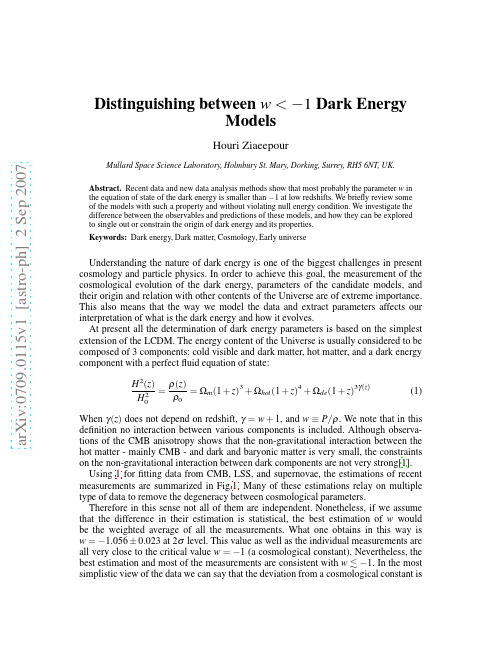
a r X i v :0709.0115v 1 [a s t r o -p h ] 2 S e p 2007Distinguishing between w <−1Dark Energy ModelsHouri ZiaeepourMullard Space Science Laboratory,Holmbury St.Mary,Dorking,Surrey,RH56NT,UK.Abstract.Recent data and new data analysis methods show that most probably the parameter w in the equation of state of the dark energy is smaller than −1at low redshifts.We briefly review some of the models with such a property and without violating null energy condition.We investigate the difference between the observables and predictions of these models,and how they can be explored to single out or constrain the origin of dark energy and its properties.Keywords:Dark energy,Dark matter,Cosmology,Early universe Understanding the nature of dark energy is one of the biggest challenges in present cosmology and particle physics.In order to achieve this goal,the measurement of the cosmological evolution of the dark energy,parameters of the candidate models,and their origin and relation with other contents of the Universe are of extreme importance.This also means that the way we model the data and extract parameters affects our interpretation of what is the dark energy and how it evolves.At present all the determination of dark energy parameters is based on the simplest extension of the LCDM.The energy content of the Universe is usually considered to be composed of 3components:cold visible and dark matter,hot matter,and a dark energy component with a perfect fluid equation of state:H 2(z )ρ0=Ωm (1+z )3+Ωhot (1+z )4+Ωde (1+z )3γ(z )(1)When γ(z )does not depend on redshift,γ=w +1,and w ≡P /ρ.We note that in this definition no interaction between various components is included.Although observa-tions of the CMB anisotropy shows that the non-gravitational interaction between thehot matter -mainly CMB -and dark and baryonic matter is very small,the constraints on the non-gravitational interaction between dark components are not very strong[1].Using 1for fitting data from CMB,LSS,and supernovae,the estimations of recent measurements are summarized in Fig.1.Many of these estimations relay on multiple type of data to remove the degeneracy between cosmological parameters.Therefore in this sense not all of them are independent.Nonetheless,if we assume that the difference in their estimation is statistical,the best estimation of w would be the weighted average of all the measurements.What one obtains in this way is w =−1.056±0.023at 2σlevel.This value as well as the individual measurements are all very close to the critical value w =−1(a cosmological constant).Nevertheless,the best estimation and most of the measurements are consistent with w −1.In the most simplistic view of the data we can say that the deviation from a cosmological constant isFIGURE1.Recent estimations of w and their weighted average.due to the errors.However,considering the best estimation mentioned above,even at2σlevel w<−1.This can be the evidence of a much richer physics behind the dark energy than just a putative cosmological constant.Evidently just one number is not enough to decide about the nature of such a com-plex entity as the dark energy.There have been a number of attempts to estimate the redshift evolution of w.Although present data is not ideal for this purpose,the minimal conclusion is that it does not significantly vary up to z∼1[2].Here we want also to men-tion very briefly the issue of the techniques usually employed to determine the equation of state of the dark energy from data.In most data sets one has tofit a large number of parameters including w or its redshift expansion parameters together.Although this method is acceptable for quantities that their exact value is not crucial for their physics such asΩdm-at least not at our present level of knowledge e-the degeneracy infit re-sults can be very important for parameters close to a critical value such as w.A method based on geometrical properties of dρ/dz is suggested[3]which in one hand permits to directly measure the sign of w and its redshift dependence.On the other hand,up to certain limits its results are less affected by the uncertainty in prior parameters such as H0andΩm.Application of this method to the publicly available SN type I data shows that w<−1at least up to z∼0.5and its variation,if exists,is very small.The main argument-or rather we can call it“fear”-against w<−1is that it violates the weak energy condition i.e.P de+ρde 0.However,we should remember that this condition is written for a perfectfluid without interaction.If the interaction between various components,in particular with the dark energy,is taken into account the form of null energy condition would be much more complex and eventually w can be less than −1without violation of any fundamental law of physics.In this case the evolution of total density can be written as:ρ(z)to show that for a number of models in which dark matter and dark energy interact with each other or are not an idealfluid,the effective w when1is used to analyze the data in place of2,is smaller than−1.Here we mention a few examples of these models.The simplest example is a decaying dark matter with cosmological constant as dark energy[4].The next one is a decaying dark matter with a very small branching ratio to a light,axion-like scalar[5,6].The condensation of thisfield plays the role of a quintessencefield with an evolution very similar to a cosmological constant from very early times after formation of the meta-stable dark matter.Finally the last example we mention here is a stable dark matter interacting with a quintessencefield as dark energy[7].Many other examples can be found,but at least some of them imply a violation of equivalence principal or cosmological variation of particle masses and couplings which are strongly constrained by the non-observation of density dependent effects of dark energy at cosmological distances.How can we distinguish between these models?This task is specially more difficult in the situation where dark energy does not strongly vary with redshift.But even if it has some variation,it is very difficult to conclude the nature of the underlaying model just from a couple of parameters that determine its variation.We need additional observables more closely related to thefield theoretical aspects of the models.At present level of our knowledge about the physics beyond the Standard Model,it is very difficult to place the dark energyfield-quintessence scalar-in the zoo of particles.Nonetheless,it is possible to guess some of the possible observables.For instance,if dark matter has a non-gravitational interaction with dark energy condensate,we expect that dark energy particles are released from the condensate.As they are expected to be very light,they should make a hot dark background of non-SM nature.This process is very similar to the scattering from a Bose-Einstein condensate[8].The cosmological density of this hot component and its evolution depends on the type and strength of the interaction.These are unknown,but from constraints on the clustering of the dark energy we expect that the coupling must be very small,and therefore the density of the corresponding hot matter should be small too-probably less than CMB,nonetheless the observation of such a component can significantly help to understand the origin of dark energy.On the other hand,we should also expect some anisotropy in the dark energy at large that may be observable specially in the high precision CMB data.If the dark energy is a cosmological constant the situation is more ambiguous because we don’t yet have a generally acceptable definition for a vacuum energy.If its origin is some physics at very high energy scale-Planck or superstring scale-andfixed at very early stage in the evolution of the Universe,the dark energy would be completely static,isotropic,and have no effect other than gravity up to any measurable redshift.In this case an effective w<−1would be the signature of a non-gravitational interaction in dark matter sector,for instance slow decay of dark matter.If at least part of the remnants of the decay are SM particles,we must be able to observe them as an additional component in cosmic rays.Their energy range depends on the mass of the decaying dark matter particles and can be E 1013GeV or E 100GeV.Moreover,it must somehow correlate with the large structures.By contrast,if the remnants are all dark,then they can be only detected through their effect on the structure formation.But this can be very small and very difficult to observe.The last case we consider here is when the dark energy is the result of the condensationFIGURE2.Dark energy models with effective w<−1and their observables.of a light scalar produced during the decay of a meta-stable dark matter.It has been shown that the equation of state of the condensate is very similar to a cosmological constant[5].This model can produce a light hot dark matter-the scalar particles-an excess of visible cosmic rays,and/or dark remnants.The anisotropy of the dark energy would be very small but worth to be searched for.Fig.2summarizes the possible origins of a dark energy with effective w<−1consid-ered here and their observables.Evidently,the most important question is how we can observe the tiny and weak interacting observables explained above.In one hand,this needs drastic improvementin the precision of measurements.On the other hand,more precise observations of cosmological effects means more sensitivity to the foreground phenomena that can mislead interpretation of observations.Therefore,thefirst step in this direction is a better understanding of the foreground.On another front,the discovery of physics beyond the Standard Model by LHC can be very important for clarifying which direction(s),both theoretical and experimental,we should investigate more closely tofind the origin of the dark energy.In conclusion,we have discussed some of the possible models for dark energy with effective w<−1and without violation of the null energy condition.At present these types of dark energy are preferred by the data.Without considering any explicit imple-mentation of these models we investigated the difference between their observables and how this can help to pin-down the underlaying model.REFERENCES1. B.Bochner(2007),URL /abs/astro-ph/0702730.2. e.Riess,A.G.,ApJ656(2007),URL /abs/astro-ph/0611572.3.H.Ziaeepour,Mod.Phys.Lett.A22,1569(2007),URL/abs/astro-ph/0702519.4.H.Ziaeepour(2000),URL /abs/astro-ph/0002400.5.H.Ziaeepour,Phys.Rev.D69,063512(2004),URL /abs/astro-ph/0308515.6.H.Ziaeepour(2006),URL /abs/hep-ph/0603125.7.K.J.Das S.,Corasaniti P.S.,Phys.Rev.D73,083509(2006),URL/abs/astro-ph/0510628.8. e.Band Y.B.,Phys.Rev.Lett84,5462(2000),URL /abs/cond-mat/0005021.。
暗能量与反弹宇宙学中若干问题
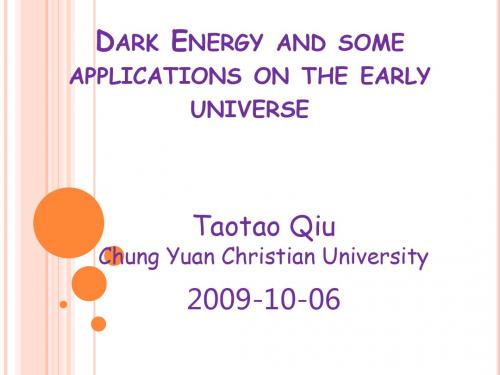
(IV)Summary
(I) Topics on Dark Energy
DARK ENERGY: A MYSTERIOUS FORCE DRIVING THE ACCELERATION OF THE UNIVERSE
Einstein Equation:
Characteristics of DE: negative pressure, non-clustering…
2.Double-field Quintom model
2.Single simple component
For multi-components:
3.Single scalar field model with Higher Derivatives
3.Minimally coupling to Gravity 4.Non-scalar models (such as spinor, vector, etc)
Candidates of Dark Energy:
I. Cosmological Constant: w=-1;
II. Quintessence -1<w<1;
III. Phantom
w<-1;
生活大爆炸第三季学习笔记(节选)

()看<The Big Bang Theory>学英语-剧情+演员+典故+单词+俚语+花边感谢本资料整理者3011.普通级词汇sass:vt. 对…出言不逊,说无礼的话effusive:adj. 流出的,感情奔放的luau:n. (常伴有文娱节目的)夏威夷式宴会toga:n. (古罗马)宽外袍,罗马主题plummeting:adj. 骤然下降,像铅球那样急速垂直下降般obnoxious:adj. 可憎的,不愉快的dictator:n. 独裁者Dickensian:adj. 如同狄更斯笔下的人物那样自私、消沉repentance:n. 悔改Mush:int. 走!,前进!trouper:n. 演员,老练演员buoy:n. 救生圈 vt. 使浮起;鼓舞,激励trajectory:n. 轨道detour:n. 绕路,迂回blunder:n. 大错scathing:adj. 严厉的,尖刻的doozy:n. 非常好或非常糟糕的东西heathen:n. 异教徒turtleneck:n. 高领tumbleweeds:n. 风滚草red-eye:n. 通宵航班demon:n. 魔鬼2.爆炸级词汇post hoc ergo propter hoc:[拉丁语]发生于其后者必然是其结果(指一种普通的逻辑上的谬误,即后此谬误)Vulcan:瓦肯人(from the Star Trek),相信大家都不陌生了,Spock那群人,耳朵尖尖,听力好,有如葫芦娃里二娃的顺风耳(字幕组真是油菜)cosmological constant:宇宙常数,含宇宙常数项的场方程是R_uv-1/2*R*g_uv+L*g_uv=κ*T_uv,其中L代表宇宙常数,其物理意义是宇宙真空场。
L*g_uv为宇宙常数项。
R_uv为里契张量,代表空间的弯曲状况。
T_uv为能量-动量张量,代表物质分布和运动状况。
g_uv为度规,κ为系数,可由低速的牛顿理论来确定。
Dark Energy Accelerating the Cosmos
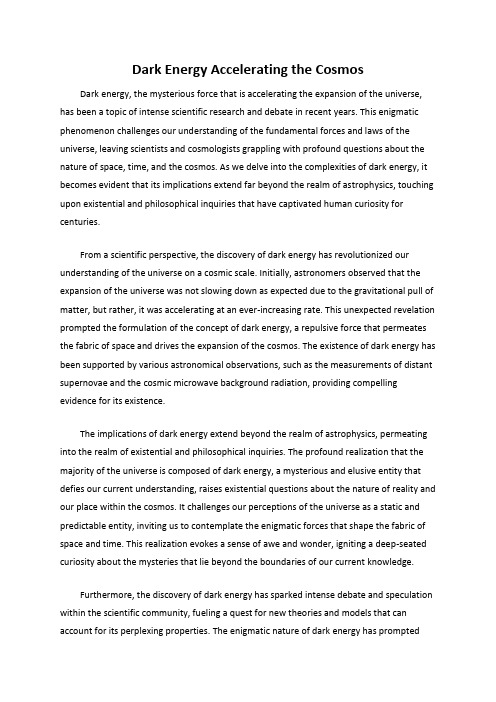
Dark Energy Accelerating the Cosmos Dark energy, the mysterious force that is accelerating the expansion of the universe, has been a topic of intense scientific research and debate in recent years. This enigmatic phenomenon challenges our understanding of the fundamental forces and laws of the universe, leaving scientists and cosmologists grappling with profound questions about the nature of space, time, and the cosmos. As we delve into the complexities of dark energy, it becomes evident that its implications extend far beyond the realm of astrophysics, touching upon existential and philosophical inquiries that have captivated human curiosity for centuries.From a scientific perspective, the discovery of dark energy has revolutionized our understanding of the universe on a cosmic scale. Initially, astronomers observed that the expansion of the universe was not slowing down as expected due to the gravitational pull of matter, but rather, it was accelerating at an ever-increasing rate. This unexpected revelation prompted the formulation of the concept of dark energy, a repulsive force that permeates the fabric of space and drives the expansion of the cosmos. The existence of dark energy has been supported by various astronomical observations, such as the measurements of distant supernovae and the cosmic microwave background radiation, providing compelling evidence for its existence.The implications of dark energy extend beyond the realm of astrophysics, permeating into the realm of existential and philosophical inquiries. The profound realization that the majority of the universe is composed of dark energy, a mysterious and elusive entity that defies our current understanding, raises existential questions about the nature of reality and our place within the cosmos. It challenges our perceptions of the universe as a static and predictable entity, inviting us to contemplate the enigmatic forces that shape the fabric of space and time. This realization evokes a sense of awe and wonder, igniting a deep-seated curiosity about the mysteries that lie beyond the boundaries of our current knowledge.Furthermore, the discovery of dark energy has sparked intense debate and speculation within the scientific community, fueling a quest for new theories and models that can account for its perplexing properties. The enigmatic nature of dark energy has promptedcosmologists to reconsider and refine existing theories of the universe, such as the nature of gravity and the behavior of fundamental particles. This pursuit of knowledge has led to a renaissance in theoretical physics, as scientists grapple with the profound implications of dark energy and strive to unravel its mysteries.On a more personal level, the concept of dark energy evokes a sense of humility and wonder at the vastness and complexity of the universe. It invites us to contemplate our place within the cosmic tapestry, prompting introspection and philosophical contemplation about the nature of existence and the fundamental forces that govern the universe. The realization that the majority of the universe is composed of dark energy, an invisible and enigmatic force that eludes direct detection, humbles our perceptions of the cosmos and invites us to embrace the unknown with a sense of curiosity and wonder.In conclusion, the enigmatic phenomenon of dark energy presents a profound challenge to our understanding of the universe, sparking intense scientific inquiry and philosophical contemplation. Its discovery has revolutionized our perceptions of the cosmos, prompting a renaissance in theoretical physics and cosmology as scientists strive to unravel its mysteries. Beyond its scientific implications, dark energy invites us to ponder existential and philosophical questions about the nature of reality and our place within the vast cosmic tapestry. As we continue to grapple with the profound implications of dark energy, we are reminded of the enduring human quest for knowledge and understanding, as we seek to unravel the mysteries that lie beyond the boundaries of our current knowledge.。
Quantum Informational Dark Energy Dark energy from forgetting
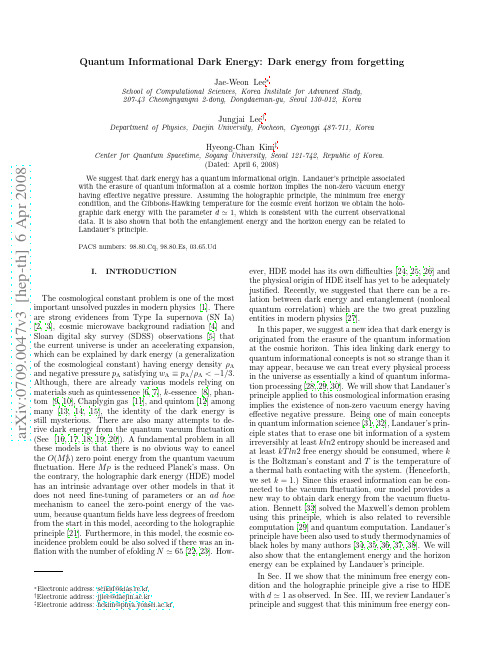
Jungjai Lee†
Department of Physics, Daejin University, Pocheon, Gyeonggi 487-711, Korea
Hyeong-Chan Kim‡
arXiv:0709.0047v3 [hep-th] 6 Apr 2008
Center for Quantum Spacetime, Sogang University, Seoul 121-742, Republic of Korea. (Dated: April 6, 2008) We suggest that dark energy has a quantum informational origin. Landauer’s principle associated with the erasure of quantum information at a cosmic horizon implies the non-zero vacuum energy having effective negative pressure. Assuming the holographic principle, the minimum free energy condition, and the Gibbons-Hawking temperature for the cosmic event horizon we obtain the holographic dark energy with the parameter d ≃ 1, which is consistent with the current observational data. It is also shown that both the entanglement energy and the horizon energy can be related to Landauer’s principle.
Dark energy and dissipation
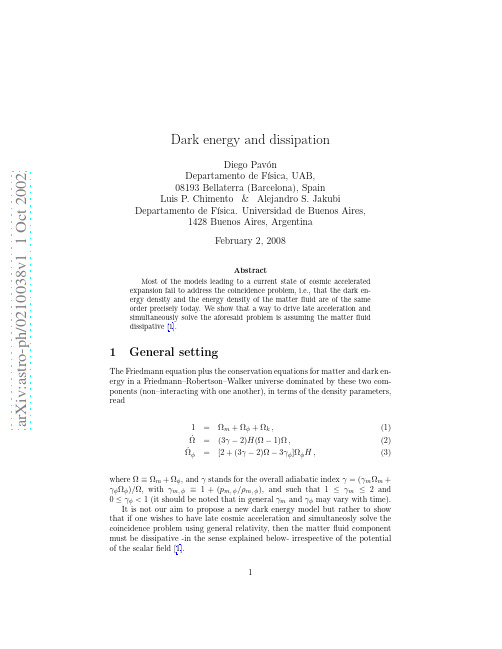
From the above equations it is immediately seen that for Ω = 1 Eq. (3) implies that Ω˙ φ > 0. Consequently, at large times Ωφ → 1 and Ωm → 0, i.e., the accelerated expansion (q < 0 =⇒ γφ < 2/3) and the coincidence problem cannot be solved simultaneously within this approach. Moreover, for the solution Ω = 1 to be stable the overall adiabatic index must comply with the upper bound γ < 2/3 which is uncomfortably low.
2
celeration together with the fact that both density parameters tend to constant values compatible with observation.
Moreover we have shown that, for a wide class of dissipative dark energy models, attractor solutions are themselves attracted towards a common asymptotic behavior. This “superattractor” regime provides a model of the recent universe that also exhibits an excellent fit to supernovae luminosity observations and no age conflict [7].
暴涨宇宙学与暗能量
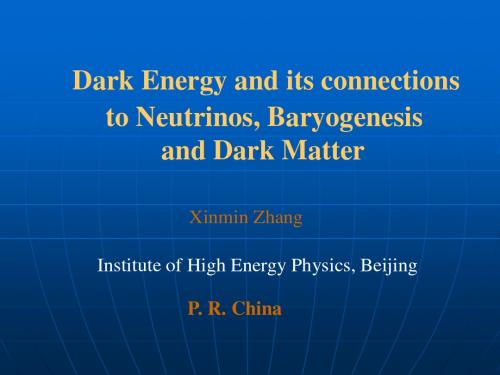
Dark Energy and neutrinos:
Any connection between Dark Energy and neutrinos? 1. ΛCDM: (10 ev) (m ) m 2. QCDM: m 10 eV M
II.
Implications in CMB: W. Hu astro-ph/0410680 R. Caldwell and Doran: astro-ph/0501104 G. Zhao, J. Xia, M. Li, B. Feng and X. Zhang: astro-ph/0507482
III. Different from cosmological constant, Quintessence and Phantom in the determination of the evolutions and the fate of the universe A lot of studies on the evolution of UNIVERSE with w across -1 just give one example: Oscillating Quintom
Two comments: 1. Parameterization dependent 2. Effects of perturbations
w( z ) w0 w1 z
Astro-ph/0507170
Astro-ph/0507482
W1 = 20
科技英语阅读翻译-推荐下载
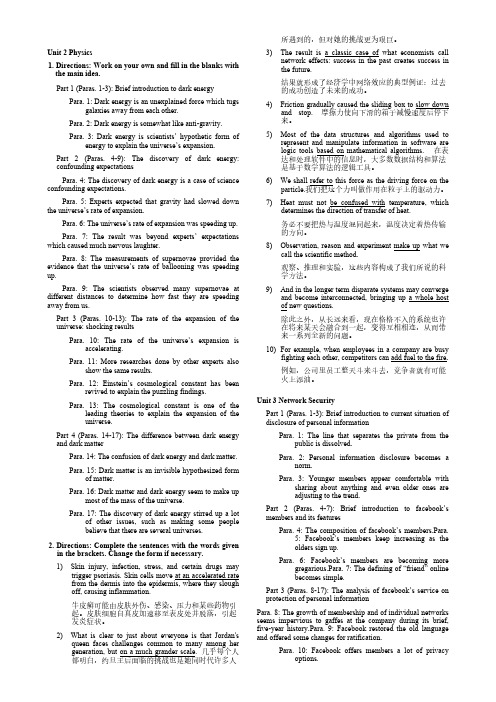
Unit 2 Physics1. Directions: Work on your own and fill in the blanks with the main idea.Part 1 (Paras. 1-3): Brief introduction to dark energyPara. 1: Dark energy is an unexplained force which tugs galaxies away from each other.Para. 2: Dark energy is somewhat like anti-gravity.Para. 3: Dark energy is scientists’ hypothetic form of energy to explain the universe’s expansion.Part 2 (Paras. 4-9): The discovery of dark energy: confounding expectationsPara. 4: The discovery of dark energy is a case of science confounding expectations.Para. 5: Experts expected that gravity had slowed down the universe’s rate of expansion.Para. 6: The universe’s rate of expansion was speeding up.Para. 7: The result was beyond experts’ expectations which caused much nervous laughter.Para. 8: The measurements of supernovae provided the evidence that the universe’s rate of ballooning was speeding up.Para. 9: The scientists observed many supernovae at different distances to determine how fast they are speeding away from us.Part 3 (Paras. 10-13): The rate of the expansion of the universe: shocking resultsPara. 10: The rate of the universe’s expansion is accelerating.Para. 11: More researches done by other experts also show the same results.Para. 12: Einstein’s cosmological constant has been revived to explain the puzzling findings.Para. 13: The cosmological constant is one of the leading theories to explain the expansion of theuniverse.Part 4 (Paras. 14-17): The difference between dark energy and dark matterPara. 14: The confusion of dark energy and dark matter.Para. 15: Dark matter is an invisible hypothesized form of matter.Para. 16: Dark matter and dark energy seem to make up most of the mass of the universe.Para. 17: The discovery of dark energy stirred up a lot of other issues, such as making some peoplebelieve that there are several universes.2. Directions: Complete the sentences with the words givenin the brackets. Change the form if necessary.1)Skin injury, infection, stress, and certain drugs maytrigger psoriasis. Skin cells move at an accelerated ratefrom the dermis into the epidermis, where they sloughoff, causing inflammation.牛皮癣可能由皮肤外伤、感染、压力和某些药物引起。
A Holographic Dark Energy Model from Ricci Scalar Curvature
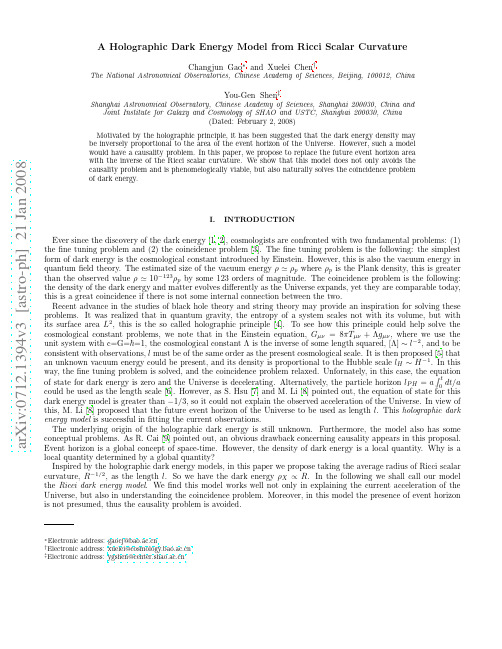
Recent advance in the studies of black hole theory and string theory may provide an inspiration for solving these
problems. It was realized that in quantum gravity, the entropy of a system scales not with its volume, but with
quantum field theory. The estimated size of the vacuum energy ρ ≃ ρp where ρp is the Plank density, this is greater than the observed value ρ ≃ 10−123ρp by some 123 orders of magnitude. The coincidence problem is the following:
Alternatively, the particle horizon lP H
=a
t 0
dt/a
could be used as the length scale [6]. However, as S. Hsu [7] and M. Li [8] pointed out, the equation of state for this
its surface area L2, this is the so called holographic principle [4]. To see how this principle could help solve the
cosmological constant problems, we note that in the Einstein equation, Gµν = 8πTµν + Λgµν, where we use the unit system with c=G= =1, the cosmological constant Λ is the inverse of some length squared, [Λ] ∼ l−2, and to be
什么是暗能量
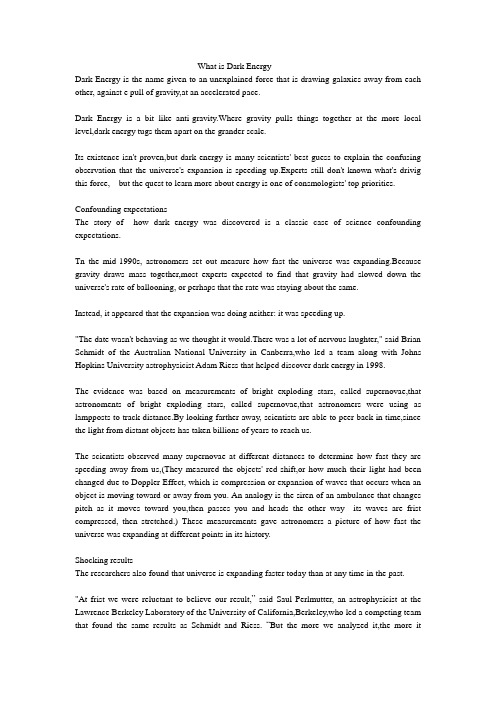
What is Dark EnergyDark Energy is the name given to an unexplained force that is drawing galaxies away from each other, against e pull of gravity,at an accelerated pace.Dark Energy is a bit like anti-gravity.Where gravity pulls things together at the more local level,dark energy tugs them apart on the grander scale.Its existence isn't proven,but dark energy is many scientists' best guess to explain the confusing observation that the universe's expansion is speeding up.Experts still don't known what's drivig this force, but the quest to learn more about energy is one of consmologists' top priorities.Confounding expectationsThe story of how dark energy was discovered is a classic case of science confounding expectations.Tn the mid-1990s, astronomers set out measure how fast the universe was expanding.Because gravity draws mass together,most experts expected to find that gravity had slowed down the universe's rate of ballooning, or perhaps that the rate was staying about the same.Instead, it appeared that the expansion was doing neither: it was speeding up."The date wasn't behaving as we thought it would.There was a lot of nervous laughter," said Brian Schmidt of the Australian National University in Canberra,who led a team along with Johns Hopkins University astrophysicist Adam Riess that helped discover dark energy in 1998.The evidence was based on measurements of bright exploding stars, called supernovae,that astronoments of bright exploding stars, called supernovae,that astronomers were using as lampposts to track distance.By looking farther away, scientists are able to peer back in time,since the light from distant objects has taken billions of years to reach us.The scientists observed many supernovae at different distances to determine how fast they are speeding away from us,(They measured the objects' red-shift,or how much their light had been changed due to Doppler Effect, which is compression or expansion of waves that occurs when an object is moving toward or away from you. An analogy is the siren of an ambulance that changes pitch as it moves toward you,then passes you and heads the other way---its waves are frist compressed, then stretched.) These measurements gave astronomers a picture of how fast the universe was expanding at different points in its history.Shocking resultsThe researchers also found that universe is expanding faster today than at any time in the past."At frist we were reluctant to believe our result,”said Saul Perlmutter, an astrophysicist at the Lawrence Berkeley Laboratory of the University of California,Berkeley,who led a competing team that found the same results as Schmidt and Riess. “But the more we analyzed it,the more itwouldn’t go away.”To explain these puzzling findings,some scientists have revived an old idea of Einstein’s that had been discarded as false:that the vacuum of space has energy in it that acts repulsively and accelerates the expansion of the universe.Enistein called this idea the cosmological constant, and referred to it as his “biggest blunder”.Now the cosmological constant is one of the leading theories of why the universe is blowing up like a balloon at ever-increasing speed.Dark matterDark energy is sometimes confused with the similarly mysterious dark matter,though the two are separate entities.Dark matter is a hypothesized form of matter that doesn’t interact with light,so it is invisible. Astronomers deduced its presence by noting its gravitational pull on stars in galaxies.Taken together, dark matter and dark energy are considered to be two forms of the same thing, thanks to Einstein’s famous equation E=mc2 1).Dark energy is thought to account for 74 percent of the universe, while dark matter adds about 22 percent, and normal, visible matter contributes a puny 4 percent.As if the discovery of dark energy weren’t bizarre enough, it has stirred up a whole host of other issues.For example,dark energy adds fuel to the fire of of believers in multiple universes, or the idea that our own existence are different. There might be other universes in which dark energy doesn’t exist, and universe does slow in its expansion, cosmologists say. Maybe that’s why our universe is so peculiar.。
Dark Matter and Dark Energy
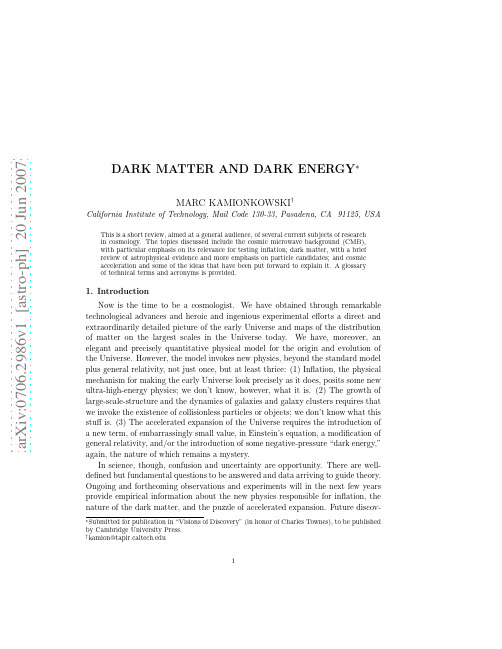
Now is the time to be a cosmologist. We have obtained through remarkable technological advances and heroic and ingenious experimental efforts a direct and extraordinarily detailed picture of the early Universe and maps of the distribution of matter on the largest scales in the Universe today. We have, moreover, an elegant and precisely quantitative physical model for the origin and evolution of the Universe. However, the model invokes new physics, beyond the standard model plus general relativity, not just once, but at least thrice: (1) Inflation, the physical mechanism for making the early Universe look precisely as it does, posits some new ultra-high-energy physics; we don’t know, however, what it is. (2) The growth of large-scale-structure and the dynamics of galaxies and galaxy clusters requires that we invoke the existence of collisionless particles or objects; we don’t know what this stuff is. (3) The accelerated expansion of the Universe requires the introduction of a new term, of embarrassingly small value, in Einstein’s equation, a modification of general relativity, and/or the introduction of some negative-pressure “dark energy,” again, the nature of which remains a mystery.
历年考研英语阅读真题及答案解析
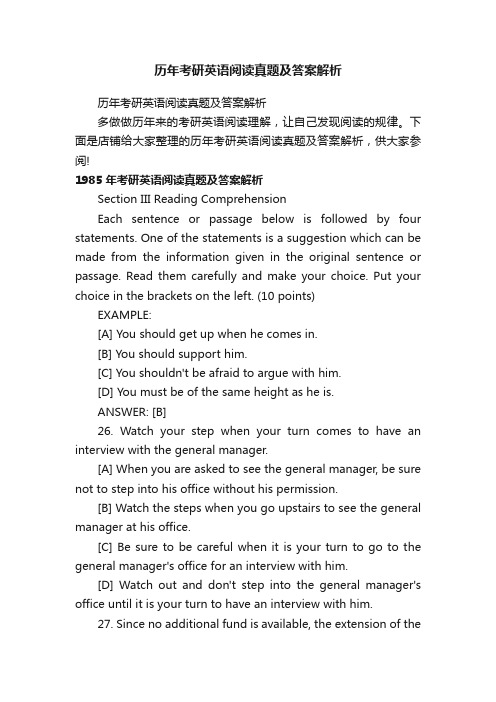
历年考研英语阅读真题及答案解析历年考研英语阅读真题及答案解析多做做历年来的考研英语阅读理解,让自己发现阅读的规律。
下面是店铺给大家整理的历年考研英语阅读真题及答案解析,供大家参阅!1985年考研英语阅读真题及答案解析Section III Reading ComprehensionEach sentence or passage below is followed by four statements. One of the statements is a suggestion which can be made from the information given in the original sentence or passage. Read them carefully and make your choice. Put your choice in the brackets on the left. (10 points)EXAMPLE:[A] You should get up when he comes in.[B] You should support him.[C] You shouldn't be afraid to argue with him.[D] You must be of the same height as he is.ANSWER: [B]26. Watch your step when your turn comes to have an interview with the general manager.[A] When you are asked to see the general manager, be sure not to step into his office without his permission.[B] Watch the steps when you go upstairs to see the general manager at his office.[C] Be sure to be careful when it is your turn to go to the general manager's office for an interview with him.[D] Watch out and don't step into the general manager's office until it is your turn to have an interview with him.27. Since no additional fund is available, the extension of thebuilding is out of the question.[A] The extension of the building is impossible because we are unable to get extra fund for the purpose.[B] There is some problem about the extension of the building owing to lack of fund.[C] Since no additional fund is available, we have to solve the problem regarding the extension of the building with our own resources.[D] We can undertake the extension of the building even without additional fund. It is no problem at all.28. All along he has been striving not to fall short of his parents' expectations.[A] He has been trying hard all the time to live up to what his parents expect of him.[B] His parents have been expecting him to work hard.[C] All the time he has been trying hard to balance himself so as not to fall down as his parents thought he would.[D] All the time, as his parents expect him to do, he has been trying hard to save and not to be short of money.29. The various canals which drain away the excessive water have turned this piece of land into a highly productive agricultural area.[A] The canals have been used to water the land.[B] The canals have been used to raise agricultural production.[C] Excessive water has been helpful to agricultural production.[D] The production has been mainly agricultural.30. The replacement of man by machines has not led to unemployment. On the contrary, the total numbers engaged inthe textile industry have continued to rise. The fact should not be ignored by those who maintain that unemployment and machinery are inseparable companions.[A] The belief that the use of machinery causes unemployment is unfounded.[B] The use of machinery results in a rise in production.[C] Many people lose their jobs when machines are introduced.[D] Contrary to general belief, machinery and unemployment are inseparable companions.答案解析Section III: Reading Comprehension (10 points)26.[C]27.[A]28.[A]29.[B]30.[A]1986年考研英语阅读真题及答案解析Section III Reading ComprehensionEach of the two passages below is followed by five questions. For each question there are four answers. Read the passages carefully and choose the best answer to each of the questions. Put your choice in the brackets on the left. (10 points) Text 1There are a great many careers in which the increasing emphasis is on specialization. You find these careers in engineering, in production, in statistical work, and in teaching. But there is an increasing demand for people who are able to take in great area at a glance, people who perhaps do not know too much about any one field. There is, in other words, a demand for people who are capable of seeing the forest rather than the trees, of making general judgments. We can call these people “generalists.” And these “generalists” are particularly needed for positions in administration, where it is their job to see thatother people do the work, where they have to plan for other people, to organize other people’s work, to begin it and judge it.The specialist understands one field; his concern is with technique and tools. He is a “trained” man; and his educationa l background is properly technical or professional. The generalist -- and especially the administrator -- deals with people; his concern is with leadership, with planning, and with direction giving. He is an “educated” man; and the humanities are his strongest foundation. Very rarely is a specialist capable of being an administrator. And very rarely is a good generalist also a good specialist in particular field. Any organization needs both kinds of people, though different organizations need them in different proportions. It is your task to find out, during your training period, into which of the two kinds of jobs you fit, and to plan your career accordingly.Your first job may turn out to be the right job for you -- but this is pure accident. Certainly you should not change jobs constantly or people will become suspicious of your ability to hold any job. At the same time you must not look upon the first job as the final job; it is primarily a training job, an opportunity to understand yourself and your fitness for being an employee.26. There is an increasing demand for ________.[A] all round people in their own fields[B] people whose job is to organize other people’s work[C] generalists whose educational background is either technical or professional[D] specialists whose chief concern is to provide administrative guidance to others27. The specialist is ________.[A] a man whose job is to train other people[B] a man who has been trained in more than one fields[C] a man who can see the forest rather than the trees[D] a man whose concern is mainly with technical or professional matters28. The administrator is ________.[A] a “trained” man who is more a specialist than a generalist[B] a man who sees the trees as well as the forest[C] a man who is very strong in the humanities[D] a man who is an “educated” specialist29. During your training period, it is important ________.[A] to try to be a generalist[B] to choose a profitable job[C] to find an organization which fits you[D] to decide whether you are fit to be a specialist or a generalist30. A man’s first job ________.[A] is never the right job for him[B] should not be regarded as his final job[C] should not be changed or people will become suspicious of his ability to hold any job[D] is primarily an opportunity to fit himself for his final jobText 2At the bottom of the world lies a mighty continent still wrapped in the Ice Age and, until recent times, unknown to man. It is a great land mass with mountain ranges whose extent and elevation are still uncertain. Much of the continent is a complete blank on our maps. Man has explored, on foot, less than one per cent of its area. Antarctica differs fundamentally from the Arcticregions. The Arctic is an ocean, covered with drifting packed ice and hemmed in by the land masses of Europe, Asia, and North America. The Antarctic is a continent almost as large as Europe and Australia combined, centered roughly on the South Pole and surrounded by the most unobstructed water areas of the world -- the Atlantic, Pacific, and Indian Oceans.The continental ice sheet is more than two miles high in its centre, thus, the air over the Antarctic is far more refrigerated than it is over the Arctic regions. This cold air current from the land is so forceful that it makes the nearby seas the stormiest in the world and renders unlivable those regions whose counterparts at the opposite end of the globe are inhabited. Thus, more than a million persons live within 2,000 miles of the North Pole in an area that includes most of Alaska, Siberia, and Scandinavia -- a region rich in forest and mining industries. Apart from a handful of weather stations, within the same distance of the South Pole there is not a single tree, industry, or settlement.31. The best title for this selection would be ________.[A] Iceland[B] Land of Opportunity[C] The Unknown Continent[D] Utopia at Last32. At the time this article was written, our knowledge of Antarctica was ________.[A] very limited[B] vast[C] fairly rich[D] nonexistent33. Antarctica is bordered by the ________.[A] Pacific Ocean[B] Indian Ocean[C] Atlantic Ocean[D] All three34. The Antarctic is made uninhabitable primarily by ________.[A] cold air[B] calm seas[C] ice[D] lack of knowledge about the continent35. According to this article ________.[A] 2,000 people live on the Antarctic Continent[B] a million people live within 2,000 miles of the South Pole[C] weather conditions within a 2,000 mile radius of the South Pole make settlements impractical[D] only a handful of natives inhabit Antarctica答案解析Section III: Reading Comprehension (10 points)26.[B]27.[D]28.[C]29.[D]30.[B]31.[C]32.[A]33.[D]34.[A]35.[C]1987年考研英语阅读真题及答案解析Section II Reading ComprehensionEach of three passages below is followed by five questions. For each question there are four answers, read the passages carefully and choose the best answer to each of the questions. Put your choice in the ANSWER SHEET. (15 points)Text 1For centuries men dreamed of achieving vertical flight. In 400 A.D. Chinese children played with a fan-like toy that spun upwards and fell back to earth as rotation ceased. Leonardo da Vinci conceive the first mechanical apparatus, called a “Helix,” which could carry man straight up, but was only a design and wasnever tested.The ancient-dream was finally realized in 1940 when a Russian engineer piloted a strange looking craft of steel tubing with a rotating fan on top. It rose awkwardly and vertically into the air from a standing start, hovered a few feet above the ground, went sideways and backwards, and then settled back to earth. The vehicle was called a helicopter.Imaginations were fired. Men dreamed of going to work in their own personal helicopters. People anticipate that vertical flight transports would carry millions of passengers as do the airliners of today. Such fantastic expectations were not fulfilled.The helicopter has now become an extremely useful machine. It excels in military missions, carrying troops, guns and strategic instruments where other aircraft cannot go. Corporations use them as airborne offices, many metropolitan areas use them in police work, construction and logging companies employ them in various advantageous ways, engineers use them for site selection and surveying, and oil companies use them as the best way to make offshore and remote work stations accessible to crews and supplies. Any urgent mission to a hard-to-get-to place is a likely task for a helicopter. Among their other multitude of used: deliver people across town, fly to and from airports, assist in rescue work, and aid in the search for missing or wanted persons.11. People expect that ________.[A] the airliners of today would eventually be replaced by helicopters[B] helicopters would someday be able to transport large number of people from place to place as airliners are now doing[C] the imaginations fired by the Russian engineer’sinvention would become a reality in the future[D] their fantastic expectations about helicopters could be fulfilled by airliners of today12. Helicopters work with the aid of ________.[A] a combination of rotating devices in front and on top[B] a rotating device topside[C] one rotating fan in the center of the aircraft and others at each end[D] a rotating fan underneath for lifting13. What is said about the development of the helicopter?[A] Helicopters have only been worked on by man since 1940.[B] Chinese children were the first to achieve flight in helicopters.[C] Helicopters were considered more dangerous than the early airplanes.[D] Some people thought they would become widely used by average individuals.14. How has the use of helicopters developed?[A] They have been widely used for various purposes.[B] They are taking the place of high-flying jets.[C] They are used for rescue work.[D] They are now used exclusively for commercial projects.15. Under what conditions are helicopters found to be absolutely essential?[A] For overseas passenger transportation.[B] For extremely high altitude flights.[C] For high-speed transportation.[D] For urgent mission to places inaccessible to other kinds of craft.Text 2In ancient Greece athletic festivals were very important and had strong religious associations. The Olympian athletic festival held every four years in honor of Zeus, king of the Olympian Gods, eventually lost its local character, became first a national event and then, after the rules against foreign competitors had been abolished, international. No one knows exactly how far back the Olympic Games go, but some official records date from 776 B.C. The games took place in August on the plain by Mount Olympus. Many thousands of spectators gathered from all parts of Greece, but no married woman was admitted even as a spectator. Slaves, women and dishonored persons were not allowed to compete. The exact sequence of events uncertain, but events included boy’s gymnastics, boxing, wrestling, horse racing and field events, though there were fewer sports involved than in the modern Olympic Games.On the last day of the Games, all the winners were honored by having a ring of holy olive leaves placed on their heads. So great was the honor that the winner of the foot race gave his name to the year of his victory. Although Olympic winners received no prize money, they were, in fact, richly rewarded by their state authorities. How their results compared with modern standards, we unfortunately have no means of telling.After an uninterrupted history of almost 1,200 years, the Games were suspended by the Romans in 394 A.D. They continued for such a long time because people believed in the philosophy behind the Olympics: the idea that a healthy body produced a healthy mind, and that the spirit of competition in sports and games was preferable to the competition that caused wars. It was over 1,500 years before another such international athletic gathering took place in Athens in 1896.Nowadays, the Games are held in different countries in turn. The host country provides vast facilities, including a stadium, swimming pools and living accommodation, but competing courtiers pay their own athletes’ expenses.The Olympics start with the arrival in the stadium of a torch, lighted on Mount Olympus by the sun’s rays. It is carried by a succession of runners to the stadium. The torch symbolized the continuation of the ancient Greek athletic ideals, and it burns throughout the Games until the closing ceremony. The well-known Olympic flag, however, is a modern conception: the five interlocking rings symbolize the uniting of all five continents participating in the Games.16. In ancient Greece, the Olympic Games ________.[A] were merely national athletic festivals[B] were in the nature of a national event with a strong religious colour[C] had rules which put foreign participants in a disadvantageous position[D] were primarily national events with few foreign participants17. In the early days of ancient Olympic Games ________.[A] only male Greek athletes were allowed to participate in the games[B] all Greeks, irrespective of sex, religion or social status, were allowed to take part[C] all Greeks, with the exception of women, were allowed to compete in Games[D] all male Greeks were qualified to compete in the Games18. The order of athletic events at the ancient Olympics ________.[A] has not definitely been established[B] varied according to the number of foreign competitors[C] was decided by Zeus, in whose honor the Games were held[D] was considered unimportant19. Modern athletes’ results cannot be compared with those of ancient runners because ________.[A] the Greeks had no means of recording the results[B] they are much better[C] details such as the time were not recorded in the past[D] they are much worse20. Nowadays, the athletes’ expenses are paid for ________.[A] out of the prize money of the winners[B] out of the funds raised by the competing nations[C] by the athletes themselves[D] by contributions焦点导航考研英语完型 | 考研英语真题 | 考研英语阅读 | 考研英语翻译 | 考研英语经验交流考研英语作文 | 考研常见问题 | 专家解读Text 3In science the meaning of the word “explain” suffers with civilization’s every step in search of reality. Science cannot really explain electricity, magnetism, and gravitation; their effects can be measured and predicted, but of their nature no more is known to the modern scientist than to Thales who first looked into the nature of the electrification of amber, a hard yellowish-brown gum. Most contemporary physicists reject the notion that man can ever discover what these mysterious forces “really” are. “Electricity,” Bertrand Russell says, “is not a thing, like St.Paul’s Cathe dral; it is a way in which things behave. When we have told how things behave when they are electrified, and under what circumstances they are electrified, we have told all there is to tell.” Until recently scientists would have disapproved of such an idea. Aristotle, for example, whose natural science dominated Western thought for two thousand years, believed that man could arrive at an understanding of reality by reasoning from self-evident principles. He felt, for example, that it is a self-evident principle that everything in the universe has its proper place, hence one can deduce that objects fall to the ground because that’s where they belong, and smoke goes up because that’s where it belongs. The goal of Aristotelian science was to explain why things happen. Modern science was born when Galileo began trying to explain how things happen and thus originated the method of controlled experiment which now forms the basis of scientific investigation.21. The aim of controlled scientific experiments is ________.[A] to explain why things happen[B] to explain how things happen[C] to describe self-evident principles[D] to support Aristotelian science22. What principles most influenced scientific thought for two thousand years?[A] the speculations of Thales[B] the forces of electricity, magnetism, and gravity[C] Aristotle’s natural science[D] Galileo’s discoveries23. Bertrand Russell’s notion about electricity is ________.[A] disapproved of by most modern scientists[B] in agreement with Aristotle’s theo ry of self-evidentprinciples[C] in agreement with scientific investigation directed toward “how” things happen[D] in agreement with scientific investigation directed toward “why” things happen24. The passage says that until recently scientists disagreed with the idea ________.[A] that there are mysterious forces in the universe[B] that man cannot discover what forces “really” are[C] that there are self-evident principles[D] that we can discover why things behave as they do25. Modern science came into being ________.[A] when the method of controlled experiment was first introduced[B] when Galileo succeeded in explaining how things happen[C] when Aristotelian scientist tried to explain why things happen[D] when scientists were able to acquire an understanding of reality of reasoning[C] grants[D] credits答案解析Section II: Reading Comprehension (15 points)11.[B]12.[B]13.[D]14.[A]15.[D]16.[B]17.[A]18.[A]19.[C]20.[B]21.[B]22.[C]23.[C]24.[B]25.[A]1988年考研英语阅读真题及答案解析Section II Reading ComprehensionEach of the three passages below is followed by some questions. For each question there are four answers. Read thepassages carefully and chose the best answer to each of the questions. Put your choice in the ANSWER SHEET. (20 points) Text 1It doesn’t com e as a surprise to you to realize that it makes no difference what you read or study if you can’t remember it. You just waste your valuable time. Maybe you have already discovered some clever ways to keep yourself from forgetting.One dependable aid that does help you remember what you study is to have a specific purpose or reason for reading. You remember better what you read when you know why you’re reading.Why does a clerk in a store go away and leave you when your reply to her offer to help is, “No, thank you. I’m just looking”? Both you and she know that if you aren’t sure what you want, you are not likely to find it. But suppose you say instead, “Yes, thank you. I want a pair of sun glasses.” She says, “Right this way, please.” And you and she are off -- both eager to look for exactly what you want.It’s quite the same with your studying. If you chose a book at random, “just looking” for nothing in particular, you are likely to get just that -- nothing. But if you do know what you want, and if you have the right book, you are almost sure to get it. Your reasons will vary; they will include reading or studying “to find out more about”, “to understand the reasons for”, “to find out how”. A good student has a clear purpose or reason for what he is doing.This is the way it works. Before you start to study, you say to yourself something like this, “I want to know why Stephen Vincent Benet happened to write about America. I’m reading this article to find out.” Or, “I’m going to skim this story tosee what lif e was like in medieval England.” Because you know why you are reading or studying, you relate the information to your purpose and remember it better.Reading is not one single activity. At least two important processes go on at the same time. As you read, you take in ideas rapidly and accurately. But at the same time you express your own ideas to yourself as you react to what you read. You have a kind of mental conversation with the author. If you expressed your ideas orally, they might sound like this: “Ye s, I agree. That’s my opinion too.” or “Ummmm, I thought that record was broken much earlier. I’d better check those dates,” or “But there are some other facts to be considered!” You don’t just sit there taking in ideas -- you do something else, and that something else is very important.This additional process of thinking about what you read includes evaluating it, relating it to what you already know, and using it for your own purposes. In other words, a good reader is a critical reader. One part of critical reading, as you have discovered, is distinguishing between facts and opinions. Facts can be checked by evidence. Opinions are one’s own personal reactions.Another part of critical reading is judging sources. Still another part is drawing accurate inferences.16. If you cannot remember what you read or study, ________.[A] it is no surprise[B] it means you have not really learned anything[C] it means you have not chosen the right book[D] you realize it is of no importance17. Before you start reading, it is important ________.[A] to make sure why you are reading[B] to relate the information to your purpose[C] to remember what you read[D] to choose an interesting book18. Reading activity involves ________.[A] only two simultaneous processes[B] primarily learning about ideas and evaluating them critically[C] merely distinguishing between facts and opinions[D] mainly drawing accurate inferences19. A good reader is one who ________.[A] relates what he reads to his own knowledge about the subject matter[B] does lots of thinking in his reading[C] takes a critical attitude in his reading[D] is able to check the facts presented against what he has already knownText 2If you live in a large city, you are quite familiar with some of the problems of noise, but because of some of its harmful effects, you may not be aware of the extent of its influence on human behavior. Although everyone more or less knows what noise is, i.e., it is sounds that one would rather not hear, it is perhaps best to define it more precisely for scientific purposes. One such definition is that noise is sounds that are unrelated to the task at hand. Thus stimuli that at one time might be considered relevant will at another time be considered noise, depending on what one is doing at the moment. In recent years there has been a great deal of interest in the effects of noise on human behavior, and concepts such as “noise pollution” have arisen, together with movements to reduce noise.Exposure to loud noises can definitely produce a partial or complete loss of hearing, depending on the intensity, duration, and frequency composition of the noise. Many jobs present noise hazards, such as working in factories and around jet aircraft, driving farm tractors, and working (or sitting) in music halls where rock bands are playing. In general, continuous exposure to sounds of over 80 decibels (a measure of the loudness of sound) can be considered dangerous. Decibel values correspond to various sounds. Sounds above about 85 decibels may, if exposure is for a sufficient period of time, produce significant hearing loss. Actual loss will depend upon the particular frequencies to which one is exposed, and whether the sound is continuous or intermittent.Noise can have unexpected harmful effects on performance of certain kinds of tasks, for instance, if one is performing a watch keeping task that requires vigilance, in which he is responsible for detecting weak signals of some kind (e.g., watching a radar screen for the appearance of aircraft).Communicating with other people is unfavorably affected by noise. If you have ridden in the rear of a jet transport, you may have noticed that it was difficult to carry on a conversation at first, and that, eventually, you adjusted the loudness of your speech to compensate for the effect. The problem is noise.20. Noise differs from sound in that ________.[A] it is sounds that interfere with the task being done[B] it is a special type of loud sound[C] it is usually unavoidable in big cities[D] it can be defined more precisely than the latter21. One of the harmful effects of noise on human performance is that ________.[A] it reduces one’s sensitivity[B] it renders the victim helpless[C] it deprives one of the enjoyment of music[D] it drowns out conversations at worksites22. The purpose of this passage is ________.[A] to define the effects of noise on human behavior[B] to warn people of the danger of noise pollution[C] to give advice as to how to prevent hearing loss[D] to tell the difference between noise and soundText 3The traditional belief that a woman’s place is in the home and that a woman ought not to go out to work can hardly be reasonably maintained in present conditions. It is said that it is a woman’s task to care for the children, but families today tend to be small and with a year or two between children. Thus a woman’s whole period of childbearing may occur within five years. Furthermore, with compulsory education from the age of five or six her role as chief educator of her children soon ceases. Thus, even if we agree that a woman should stay at home to look after her children before they are of school age, for many women, this period would extend only for about ten years.It might be argued that the house-proud woman would still find plenty to do about the home. That may be so, but it is certainly no longer necessary for a woman to spend her whole life cooking, cleaning, mending and sewing. Washing machines take the drudgery out of laundry, the latest models being entirely automatic and able to wash and dry a large quantity of clothes in a few minutes. Refrigerators have made it possible to store food for long periods and many pre-cooked foods are obtainable in tins. Shopping, instead of being a daily task, can be completed。
Can the Existence of Dark Energy Be Directly Detected
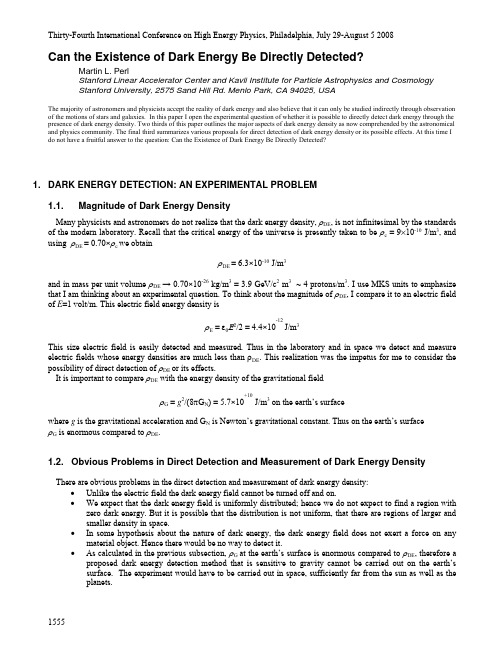
Thirty-Fourth International Conference on High Energy Physics, Philadelphia, July 29-August 5 2008Can the Existence of Dark Energy Be Directly Detected?Martin L. PerlStanford Linear Accelerator Center and Kavli Institute for Particle Astrophysics and CosmologyStanford University, 2575 Sand Hill Rd. Menlo Park, CA 94025, USAThe majority of astronomers and physicists accept the reality of dark energy and also believe that it can only be studied indirectly through observation of the motions of stars and galaxies. In this paper I open the experimental question of whether it is possible to directly detect dark energy through the presence of dark energy density. Two thirds of this paper outlines the major aspects of dark energy density as now comprehended by the astronomical and physics community. The final third summarizes various proposals for direct detection of dark energy density or its possible effects. At this time I do not have a fruitful answer to the question: Can the Existence of Dark Energy Be Directly Detected?1. DARK ENERGY DETECTION: AN EXPERIMENTAL PROBLEM1.1. Magnitude of Dark Energy DensityMany physicists and astronomers do not realize that the dark energy density, ρDE, is not infinitesimal by the standards of the modern laboratory. Recall that the critical energy of the universe is presently taken to be ρc = 9×10-10 J/m3, and using ρDE = 0.70×ρc we obtainρDE = 6.3×10-10 J/m3and in mass per unit volume ρDE →0.70×10-26 kg/m3 = 3.9 GeV/c2 m3 ~ 4 protons/m3. I use MKS units to emphasize that I am thinking about an experimental question. To think about the magnitude of ρDE, I compare it to an electric field of E=1 volt/m. This electric field energy density isρE = ε0Ε2/2= 4.4×10-12J/m3This size electric field is easily detected and measured. Thus in the laboratory and in space we detect and measure electric fields whose energy densities are much less than ρDE. This realization was the impetus for me to consider the possibility of direct detection of ρDE or its effects.It is important to compare ρDE with the energy density of the gravitational fieldρG = g2/(8πG N) = 5.7×10+10J/m3 on the earth’s surfacewhere g is the gravitational acceleration and G N is Newton’s gravitational constant. Thus on the earth’s surfaceρG is enormous compared to ρDE.1.2. Obvious Problems in Direct Detection and Measurement of Dark Energy DensityThere are obvious problems in the direct detection and measurement of dark energy density:•Unlike the electric field the dark energy field cannot be turned off and on.•We expect that the dark energy field is uniformly distributed; hence we do not expect to find a region with zero dark energy. But it is possible that the distribution is not uniform, that there are regions of larger and smaller density in space.•In some hypothesis about the nature of dark energy, the dark energy field does not exert a force on any material object. Hence there would be no way to detect it.•As calculated in the previous subsection, ρG at the earth’s surface is enormous compared to ρDE, therefore a proposed dark energy detection method that is sensitive to gravity cannot be carried out on the earth’s surface. The experiment would have to be carried out in space, sufficiently far from the sun as well as the planets.1.3. Dark Energy and the Planck ScaleNumerous discussions of dark energy are involved with the Planck scale with the so called Planck mass, M Planck, and the Planck energy, E Planck, given byM Planck= [hc/2πG N]1/2 = 1.2×1019 GeV/c2 = 2.2×10-8 kgE Planck= [hc5/2πG N]1/2 = 1.2×1019 GeV = 2.0×109 JHere h is Planck’s constant and c is the velocity of lightI am bothered by the prevalent use of E Planck in dark energy discussions. E Planck mixes a quantum mechanical constant with two classical constants, yet ignores another classical constant - the electron charge, e, that incorporates the mystery of the quantization of electric charge. Of course it common to say that the Planck energy is the region where quantum mechanics intimately intersects with general relativity and I agree with that vague idea. But what does the Planck energy have to do with dark energy? We do not know if dark energy has anything to do with gravitation. I return to this later when I summarize the infamous problem that arises when dark energy is associated with ground state vacuum fluctuation energy and E Planck is used as a cut-off.1.4. Mass Scales, Length Scales and Dark Energy1.5.1. Review of Mass and Length Scales ConceptAn early example of the use of mass and length scales is the astonishing use made by Yukawa to interpret the strong force as caused by pion exchange. We write the strong potential, V, as a function of the distance r from the potential source in the simplified form:V = -a exp(r/L strong)where a gives the strength of the potential, and L strong is the range or length scale. The general quantum mechanical relation between L and the mass m of the particle carrying the force ism×L = h/(2πc) (1) It is convenient to remember that h/(2πc)= 1.97×10-13 MeV/c2 m = 3.51×10-43 kg m. Thus for the strong force with L strong =10-15 m, we get the pion mass = 197 MeV/c2, as Yukawa predicted seventy years ago.1.5.2. Mass and Length Scales for the Weak InteractionEquation 1 works well for the weak force if we use m≈100 GeV/c2 to approximate the W and Z0 masses. Then Eq. 1 gives L weak≈ 2×10-18 m, much smaller than the strong force range as it should be.1.5.3. Mass and Length Scales at the Planck ScaleUsing Eq.1 and M Planck = 2.2×10-8 kgL Planck = 1.6×10-35 m.This length dominates string theory concepts and much theoretical work on quantum gravity1.5.4. Mass and Length Scales for Dark EnergyWe do not know a mass m for dark energy to insert in the general quantum mechanical relation of Eq. 1 to calculateL DE. We only know the dark energy density, ρDE . Therefore we resort to a dimensional argument,L DE = [hc/(2πρDE)]1/4 = 80×10-6 m = 80μm,that may have no validity. But probing dark energy is so difficult that we temporarily accept the idea. L DE corresponds to a frequencyf DE = c/ L DE = 4×1012 Hz.Note that in both of these two equations the presence or absence of factors of 2 and π are arbitrary.For later use we writeρDE = [h/(2πc3)] f DE4 (2)2. DARK ENERGY AND THE VACUUM ENERGY DENSITY2.1. The Puzzle of the Connection Between Vacuum Energy Density and Dark Energy IfThere Is a ConnectionConventional quantum mechanics requires that a ground state have non-zero energy. Following Ref. [1], a massless scalar field has ground state energies ½h f1, ½h f2 ½h f3... when the field is treated as an harmonic oscillator. The total vacuum energy density ρvac is obtained by quantizing the system in a cubic box and integrating up to some cutoff frequency f max, yieldingρvac = [hπ/(2c3)]f max4 (3)Note that Eqs. 2 and 3 are the same except for factors of 2 and π.Eq. 3 leads to an infinite quantity unless f max is finite. Using an argument I don’t like because of my mistrust of the significance of the Planck scale, it is conventional to set f max = f Planck ~ 1043 Hz. This leads to the result that has been repeated ad nauseam, ρvac/ρDE ~ (f max/ f DE)4 ~ 10120, an unacceptable result that bedevils the idea of a connection between vacuum energy and dark energy.2.2. Some Proposed Cures to the PuzzleSome proposed cures are:•Assume that since in reality there are many different fields, their contributions cancel each other exquisitely giving a small net ρvac. An impetus for this concept is the known phenomenon that bosons and fermionshave opposite sign contributions to ρvac.•Find a reason for f max to be much less than f Planck.•Make a dark energy model that has nothing to do with vacuum energy.•Question the reality of vacuum energy and so disconnect from theories about dark energy [2].3. PROPOSALS FOR DIRECT DETECTION OF DARK ENERGY OR ITS EFFECTS3.1. Superconductor Noise and Dark EnergyBeck and Mackey [3] have proposed (a) that dark energy is only connected to electromagnetic vacuum energy density with a cutoff above 4×1012Hz and (b) that this idea can be tested by looking for a decrease above 4×1012 Hz in the noise spectrum in superconductors. This proposal has been substantially criticized [4].3.2. Dark Energy and Measurements of Gravitational Force at Small DistancesIn the past fifteen years there have been several short distance measurements [5-7] of the validity of the inverse square law for the gravitational force. Distances of the order of 50 to 100 μm have been examined. One motivation for these experiments was predictions about the effect of hypothetical string theory extra dimensions on gravity. Another motivation was the possible significance of the dark energy length scale L DE = 80 μm, deduced in Sec. 1.5.4. It is usual to generalize the Newtonian gravitational equation as follows:V(r) = -G N (m1m2/r) [1+a exp(-r/λ)],where a and λ are parameters for the deviation from Newtonian physics. No deviations have been found [5-7].3.3. Might the Dark Energy Density Be Clumped?At present my thoughts are concentrated on the possibility that ρDE is not uniformly distributed, and that the clumping can be detected in space, sufficiently far away from the gravitational fields of the sun and planet s. The burning question is what can do the detection. For electromagnetic fields we have particles charge, for gravitational fields we have particle mass, but what particle property is sensitive to the dark energy field? This is the fundamental experimental question in dark energy physics. For example, what is the possibility of dark energy producing a phase shift in an atom, and using atom interferometry to detect the phase shifts?3.4. Might There Be A Dark Energy Particle?In the multitudinous world of dark energy theories the idea that there might be a dark energy particle [8] is an outlier theory. But the experimenter should think even about outliers.3.5. An Experimenter’s ConclusionAt the start of the nineteenth century physicists worked on three apparently unrelated phenomena: electricity,magnetism, light. By the end of the nineteenth century these phenomena had been united into electromagnetic theory.At the start of the twenty first century we work on gravitation, dark matter, dark energy, and many problems having to do with the nature of mass. I am optimistic that we will be as productive in fundamental astronomy and physics in the future as we have been in the last two centuries.ACKNOWLEDGMENTSI thank Garrett Morton for his participation in the preparation of this paper. I have had particularly usefulconversation on the nature of dark energy with Frans Klinkhamer, Philip Mannheim, Mark Trodden, Thomas Rizzo, Marvin Weinstein and Helen Quinn. This work was supported by Department of Energy contract DE-AC03-76SF00515.References[1] L. Bergstrom and A. Goobar, Cosmology and Particle Physics, 2nd Ed., (Springer, Berlin, 2004) p. 126.[2] S. Saunders, “Is the Zero-Point Energy Real” in Ontological Aspects of Quantum Field Theory (World Scientific,Singapore, 2002), Eds. M. Kuhlmann, H. Lyre, A. Wayne.[3] C. Beck and M. C. Mackey, Int. J. Mod. Phys., D17, 71 (2008)[4] P. Jetzer and N. Straumann, Phys. Lett., B639, 47 (2006); Phys. Lett. B606, 77 (2005).[5]J.C. Long and J.C. Price, C. R. Physique 4, 337 (2003); H. W. Long et al., Nature 421:922 (2003).[6] A. A. Geraci et al., Phys. Rev. D78, 022002 (2008).[7] D. J. Kapner et al., Phys. Rev. Lett. 98, 021101 (2007)[8] A. de la Macorra, Phys. Rev., D72, 043508 (2005); S. DeDeo, Phys. Rev. D73, 043520 (2006).。
TOEFL Junior 阅读教材

TOEFL Junior 阅读教材TOEFL JuniorReading Comprehension1目录1 TOEFL Junior 阅读宏观综述 Introduction to TOEFL Junior Reading Comprehension (3)2 TOEFL Junior 阅读题型介绍 ..................................................................... (3)2.1 词汇题 ..................................................................... . (3)2.2 事实信息题 ..................................................................... .. (4)2.3 否定事实信息题 ..................................................................... (6)2.4 指代题 ..................................................................... . (7)2.5 修辞目的题 ..................................................................... .. (9)2.6 推断题 ..................................................................... .. (10)2.7 主旨题 ..................................................................... ..................................................... 11 3 TOEFL Junior 阅读篇章练习 ..................................................................... . (12)天文类 ..................................................................... (12)地理地质类 ..................................................................... . (20)生物类 ..................................................................... (29)生态学类 ..................................................................... .. (36)古生物类 ..................................................................... .. (42)人文社会科学类 ..................................................................... .. (49)美国历史题材 ..................................................................... (54)文学艺术类 ..................................................................... . (77)21 TOEFL Junior 阅读宏观综述 Introduction to TOEFL Junior Reading ComprehensionTOEFL Junior阅读考试主要考查学生寻找文章基本信息,进行合理推理以及理解文章内容概要的能力。
Constraints on the decay of dark matter to dark energy from weak lensing bispectrum tomogra
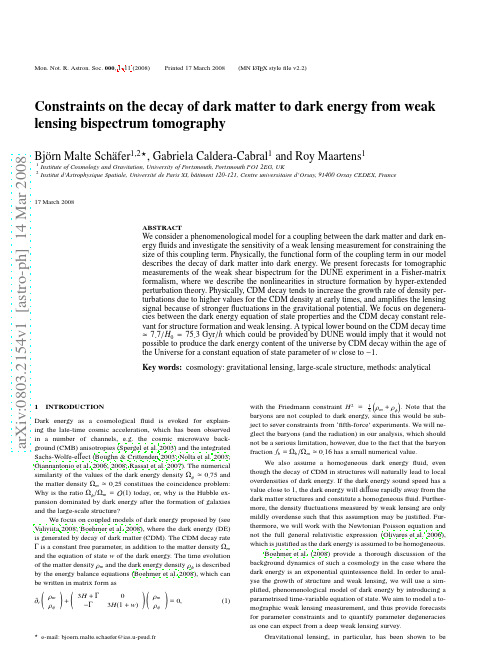
2
B.M. Sch¨ afer, G.A. Caldera-Cabral and R. Maartens
model ΛCDM ΛΓ CDM φCDM φΓ CDM Ωm 0.25 0.25 0.25 0.25 σ8 0.8 0.8 0.8 0.8 ns 1 1 1 1 w0 -1 -1 −2 3 −2 3 wa 0 0 1 −3 1 −3 Γ 0 0
1 3 1 3
a very powerful observational probe for investigating the influence of dark energy on structure formation and the geometry of the universe (Schneider et al. 1992; Mellier 1999; Bartelmann & Schneider 2001; Refregier 2003), even in the nonlinear regime of structure formation (Jain & Seljak 1997; Bernardeau et al. 1997; Benabed & Bernardeau 2001). Lensing data is best used in tomographic measurements for constraining dark energy equation of state properties (Hu 1999, 2002; Heavens 2003; Jain & Taylor 2003), where one either measures the power spectrum or the bispectrum of a weak lensing quantity (Kilbinger & Schneider 2005; Schneider & Bartelmann 1997; Bernstein & Jain 2004; Dodelson & Zhang 2005). Supplementing the recent paper by La Vacca & Colombo (2008), who derived lensing bounds on interacting models from weak lensing power spectra, we focus on bispectrum tomography, and we use a more general, albeit phenomenological cosmological model. Bispectra have the advantage that the perturbative treatment is easier to carry out and that they are sensitive on the transition from linear to nonlinear dynamics in structure formation. After introducing the cosmological model and the peculiarities of gravitational lensing in the decaying CDM models in Sect. 2, we compute the weak lensing bispectrum and tomographic measurements in Sect. 3. Fisher-constraints on cosmological parameters are derived in Sect. 4 and the main results are summarised in Sect. 5. The parameter accuracies are forecast for the weak lensing survey proposed for the Dark UNiverse Explorer1 (DUNE). For the fiducial model, we take a spatially flat ΛCDM cosmology with w = −1, adiabatic initial conditions and stable CDM (Γ = 0). Specific parameter choices are H0 = 100h km/ s/Mpc with h = 0.72, Ωm = 0.25, σ8 = 0.8 and ns = 1.
高一年级英语宇宙探索与科学发现单选题40题
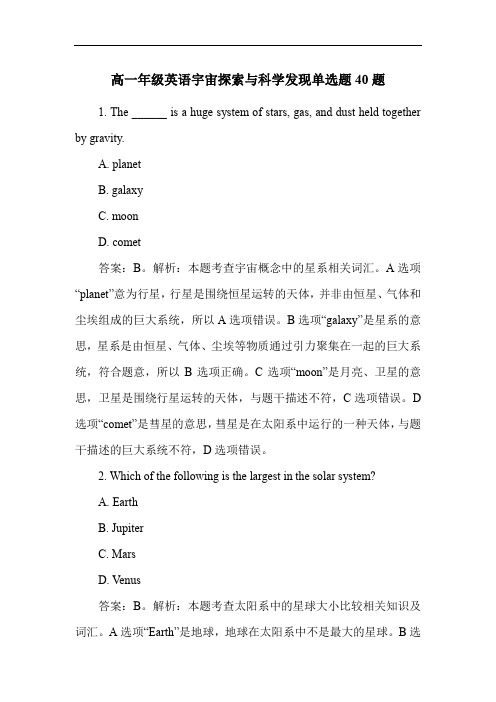
高一年级英语宇宙探索与科学发现单选题40题1. The ______ is a huge system of stars, gas, and dust held together by gravity.A. planetB. galaxyC. moonD. comet答案:B。
解析:本题考查宇宙概念中的星系相关词汇。
A选项“planet”意为行星,行星是围绕恒星运转的天体,并非由恒星、气体和尘埃组成的巨大系统,所以A选项错误。
B选项“galaxy”是星系的意思,星系是由恒星、气体、尘埃等物质通过引力聚集在一起的巨大系统,符合题意,所以B选项正确。
C选项“moon”是月亮、卫星的意思,卫星是围绕行星运转的天体,与题干描述不符,C选项错误。
D 选项“comet”是彗星的意思,彗星是在太阳系中运行的一种天体,与题干描述的巨大系统不符,D选项错误。
2. Which of the following is the largest in the solar system?A. EarthB. JupiterC. MarsD. Venus答案:B。
解析:本题考查太阳系中的星球大小比较相关知识及词汇。
A选项“Earth”是地球,地球在太阳系中不是最大的星球。
B选项“Jupiter”是木星,木星是太阳系中最大的行星,所以B选项正确。
C选项“Mars”是火星,火星比木星小,C选项错误。
D选项“Venus”是金星,金星也比木星小,D选项错误。
3. A ______ is a group of stars that form a pattern in the sky.A. constellationB. nebulaC. asteroidD. meteor答案:A。
解析:本题考查星座的概念相关词汇。
A选项“constellation”是星座的意思,星座是天空中一群组成特定图案的恒星,符合题意,A选项正确。
B选项“nebula”是星云的意思,星云是由气体和尘埃组成的云雾状天体,与星座概念不同,B选项错误。
PossibleFateoftheUniverse
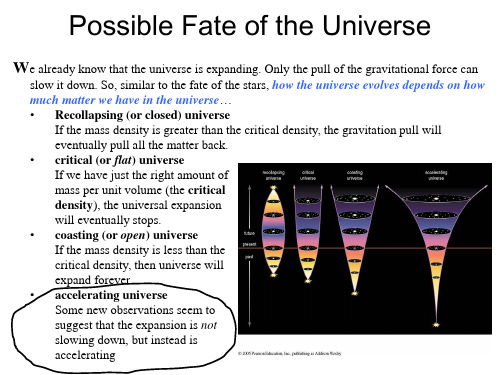
Chapter 16, Dark Matter, Dark Energy, and the Fate of the Universe
• If we know how much matter we have in the
universe, then we can predict how the universe is going to evolve in the future…
– At any particular location, Rfroosmtaotitmohneebcurosrvatdeasernosifnegwlloiifpllttihcbeaelasbmmsoeraopstvuiorienndlgines yietlodewdathredsaumse,ressoulmts –ethwatiellllbipeticals alsmo coovntianinglaarwgeaaymofurontmof udasrk, wmahttielre, absouotmtheesawmielllibkee thme sopvirianlsg!
the mass
or the merry-go-
concentrated at
round
the center, like
our solar system.
What Does the Flat Rotation Curve of the Milky Way Tell Us?
• The flat rotation curve of the Milky Way Galaxy implies that…
Measuring the Mass of Galaxy Clusters
• The mass of cluster of galaxies can
- 1、下载文档前请自行甄别文档内容的完整性,平台不提供额外的编辑、内容补充、找答案等附加服务。
- 2、"仅部分预览"的文档,不可在线预览部分如存在完整性等问题,可反馈申请退款(可完整预览的文档不适用该条件!)。
- 3、如文档侵犯您的权益,请联系客服反馈,我们会尽快为您处理(人工客服工作时间:9:00-18:30)。
a rXiv:as tr o-ph/212566v13Dec22Dark Energy:Is it Q or Λ?A.Melchiorri 1,C.J.¨Odman 21Astrophysics,Denys Wilkinson Building,University of Oxford,Keble road,OX13RH,Oxford,UK 2Astrophysics,Cavendish Laboratory,Cambridge University,Cambridge,U.K.Abstract.New observations of Cosmic Microwave Background Anisotropies,Su-pernovae luminosity distances and Galaxy Clustering are sharpening our knowledge about dark energy.Here we present the latest constraints.1Introduction The discovery of a possible accelerated expansion of our present universe from type Ia supernovae ([1]),is perhaps the most remarkable cosmological finding of recent years.Furthermore,the flatness of the universe (Ωtot =1)deter-mined by Cosmic Microwave Background observations ([2]),togheter with the low matter density (Ωmatter <0.4)inferred from Large Scale Structure ([3])are suggesting the presence of a cosmological constant with high statistical significance.However,the CMB+LSS result relies on the assumption of a particular class of models,based on adiabatic primordial fluctuations,cold dark matter and a cosmological constant as dark energy component .In the following we will refer to this class of model as Λ-Cold Dark Matter (Λ-CDM).This weak point,shared by most of the current studies,should not be overlooked:it might be possible that a different solution to the dark energy scenario than a cosmological constant can affect the CMB+LSS determination.It is therefore timely to investigate if the actual CMB data is in complete agreement with the Λ-CDM scenario or if we are losing relevant scientific informations by restricting the current analysis to a subset of models.Here first we check to what extent modifications to the standard Λ-CDMscenario are needed by current CMB observations with a model-independent analysis obtained fitting the actual data with a phenomenological function and characterizing the observed multiple peaks through a Monte Carlo Markov Chain (MCMC)algorithm,which allows us to investigate a large number of parameter simultaneously (15in our case).We found a very good agreement between the position,relative amplitude and width of the peaks obtained through the model independent approach with the same features expected in a 4-parameters model template of Λ-CDM spectra.Second,since the Λ-CDM is a good fit to the CMB data,we then move to other possible candidates for the dark energy component to see what kind of constraint we can obtain.The common characteristic of alternative scenarios to a cosmological constant,like quintessence or domain walls,is that their equations of state,w dark =p/ρ,might differ from the value for a cosmological constant,wΛ=−1.Obser-vationallyfinding w dark different from−1will therefore be a success for the alternative scenarios.We found that the present CMB and LSS data can put strong constraints on the values of w dark assumed as a constant.2Phenomenologicalfit to the CMB data and agreement with theΛ-CDM scenario.We model the multiple peaks in the CMB angular spectrum by the following function:ℓ(ℓ+1)Cℓ/2π=Ni=1∆T2i exp(−(ℓ−ℓi)2/2σ2i)(1)where,in our case,N=5.We use this formula to make a phenomenologicalfit to the current CMB data,constraining the values of the15parameters∆T i,ℓi andσi.For the CMB data,we use the recent results from the BOOMERanG-98,DASI,MAXIMA-1,CBI,and VSA experiments.The power spectra from these experiments were estimated in19,9,13,14and10bins respectively (for the CBI,we use the data from the MOSAIC configuration),spanning the range2≤ℓ≤1500.For the DASI,MAXIMA-I and VSA experiments we use the publicly available correlation matrices and window functions.For the BOOMERanG and CBI experiments we assign aflat interpolation for the spectrum in each binℓ(ℓ+1)Cℓ/2π=C B,and we approximate the signal C B inside the bin to be a Gaussian variable.The likelihood for a given phe-nomenological model is defined by−2ln L=(C ph B−C ex B)M BB′(C ph B′−C ex B′) where M BB′is the Gaussian curvature of the likelihood matrix at the peak.We consider10%,4%,5%,3.5%and5%Gaussian distributed calibration errors for the BOOMERanG-98,DASI,MAXIMA-1,VSA,and CBI experi-ments respectively and we include the beam uncertainties by the analytical marginalization method presented in([4]).The phenomenologicalfit is op-erated through a MCMC algorithm.The MCMC approach is to generate a random walk through parameter space that converges towards the most likely value of the parameters and samples the parameter space following the joint likelihood,the posterior probability distribution.A description of the method used can be found in[5].As reported in[5]we found an excellent agreement between theΛ-CDM scenario and the model-independentfit.This result is ev-ident in Figure1where we plot the best-fit phenomenological model with the best-fit obtained under the assumption of a4parametersΛ-CDM template.3Quintessence.Since the present CMB data is in wonderful agreement with theΛ-CDM sce-nario,we can now try to extend the set of theoretical models,allowing for0 1000200030004000 5000 6000 70008000 200 400 600800 1000 1200 1400l (l +1)C (l )/2p i [u K ^2]l ’Best fit Power Spectrum’Gaussians(x)’Boomerang’’Maxima’’DASI’’VSA’’CBI even’Figure 1:Comparison of the best-fit theoretical power spectrum and the best-fit model-independent power spectrum.values of the dark energy equation of state different from −1.However,as already stressed by many authors (see e.g.[6])it is necessary to combine the CMB data with different data sets in order to obtain reliable constraints,since each dataset suffers from degeneracies with the remaining cosmological param-eters.Even if one restricts consideration to flat universes and to a value of w dark constant in time then the SN-Ia luminosity distance and position of the first CMB peak are highly degenerate in w dark and Ωdark ,the energy density in quintessence.In Fig.2we report the 68%and 95%likelihood contours in the Ωdark −w dark plane [7]with the inclusion of the new CBI,VSA and Archeops datasets.The equation of state parameter is constraied to be −1.62<w dark <−0.76at 95%c.l.,in agreement with the w dark =−1cosmological constant case and giving no support to a quintessential field scenario with w dark >−1.A frustrated network of domain walls or an exponential scaling field are excluded at high significance.In addition a number of quintessential models are highly disfavored,like,for example,power law potentials with p ≥1.However dark-energy ’phantom’models with w <−1(see e.g.[8])can be in agreement with the data we considered.The result is consistent with other recent independent analyses (see [9]in these proceedings and references therein).Acknowledgements.We are grateful to Rachel Bean,Anthony Lasenby,Laura Mersini,Mike Hobson,and Mark Trodden.References[1]P.M.Garnavich et al,Ap.J.Letters 493,L53-57(1998);S.Perlmutter et al,Ap.J.483,565(1997);S.Perlmutter et al (The Supernova Cosmology Project),Nature 39151(1998);A.G.Riess et al,Ap.J.116,1009(1998);B.P.Schmidt,Ap.J.507,46-63(1998).Ωmatter W Q68%95%99%68%95%9%99%CMB+HST+SN-Ia+LSS+BBNS u p e r n o v a e Figure 2:Likelihood contours for the energy density and equation of state of dark energy.Picture taken from [7].[2] terfield et al.,[astro-ph/0104460],C.Pryke et al.,[astro-ph/0104489],A.Lee et al.,[astro-ph/0104459].[3]G.Efstathiou et al.,arXiv:astro-ph/0109152;N.A.Bahcall et al.,arXiv:astro-ph/0205490.[4]S.L.Bridle,R.Crittenden, A.Melchiorri,M.P.Hobson,R.Kneissl andsenby,arXiv:astro-ph/0112114.[5] C.J.Odman,A.Melchiorri,M.P.Hobson and senby,arXiv:astro-ph/0207286.[6]R.Bean and A.Melchiorri,Phys.Rev.D 65(2002)041302[arXiv:astro-ph/0110472].[7] A.Melchiorri,L.Mersini, C.J.Odman and M.Trodden,arXiv:astro-ph/0211522.[8]R.R.Caldwell,Phys.Lett.B 545(2002)23[arXiv:astro-ph/9908168];[9]hav,arXiv:astro-ph/0212358.。
